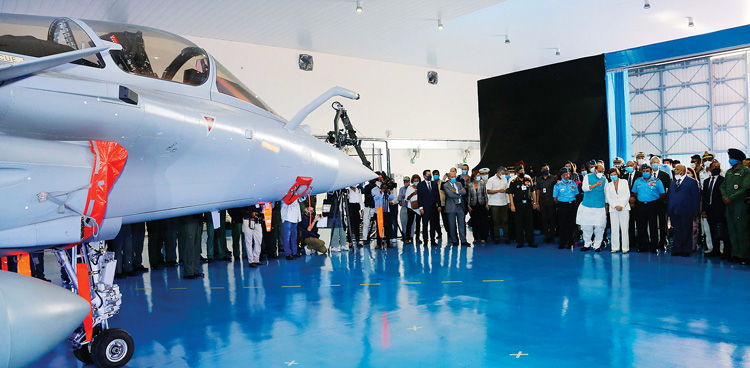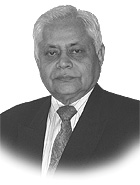INDIAN ARMED FORCES CHIEFS ON
OUR RELENTLESS AND FOCUSED PUBLISHING EFFORTS

SP Guide Publications puts forth a well compiled articulation of issues, pursuits and accomplishments of the Indian Army, over the years

I am confident that SP Guide Publications would continue to inform, inspire and influence.

My compliments to SP Guide Publications for informative and credible reportage on contemporary aerospace issues over the past six decades.
Induction of a Game Changer Into the IAF
Induction of the fleet of Rafale fighter jets will bring about a paradigm shift in the combat potential of the Indian Air Force

 | By Air Marshal B.K. Pandey (Retd) Former Air Officer Commanding-in-Chief of Training Command, IAF |
September 10, 2020 was indeed a red letter day for the Indian Air Force (IAF) when the first five Rafale jets out of the total order of 36 placed on the French aerospace major Dassault Aviation, were formally inducted into No. 17 Squadron. This squadron with a prestigious record is christened as “Golden Arrows” and is based at Air Force Station, Ambala. The remaining 31 aircraft are expected to be delivered by 2022 in batches of four arriving in India every two months. The air base at Ambala was established by the Royal Air Force of Britain more than 100 years ago and has always been a major air base for the combat aircraft fleets of the IAF as well. It was at this air base that the Anglo-French Jaguar deep penetration strike aircraft that was inducted in the mid 1980s, was located. The air base at Ambala has played a major role in all the wars that the IAF has been involved in with the Western neighbour, the most recent one being the conflict in Kargil in 1999.
Equipped with the most advanced radar and avionics, the Rafale jet is capable of delivering a wide range of weapons including the deadly Scalp and Meteor missile systems. With the attributes it is endowed with an omni-role capability, the Rafale jet is categorised as a fourth plus generation aircraft. It has been acknowledged to be one of the most advanced and versatile combat jet in service with the French Air Force as also a few other air forces in the world today. For the IAF it will certainly be the most lethal combat platform in its inventory as of date. It is opined that the induction of this fleet of fighter jets will bring about a paradigm shift in the combat potential of the IAF as well. In fact it has appropriately been described as a “game changer”.
The Rafale is the first combat aircraft procured from foreign sources to be inducted since the Sukhoi Su-30 MKIs that were supplied by Russia in the late 1990s. Although it has taken nearly two decades of effort by the IAF to procure Rafale jets, what is of significance is that induction of this fleet has commenced at a time when there is marked escalation of tension between the Chinese and Indian forces along the Line of Actual Control (LAC) in Ladakh and the possibility of war looming over the horizon. The ceremony conducted at Air Force Station, Ambala to induct the five Rafale jets into an operational squadron of the IAF, was indeed impressive. The Minister of Defence, Rajnath Singh, his French counterpart Florence Parly, Chief of Defence Staff General Bipin Rawat and Air Chief Marshal R.K.S. Bhadauria, Chief of the Air Staff were among the large number of dignitaries present to witness this historic event.
While the Rafale is undoubtedly the best and most capable combat platform that the IAF has been gifted with in its history, the grandeur with which the aircraft has been formally inducted into an operational squadron of the IAF, is somewhat unusual. Since independence, the IAF has inducted 14 different types of combat aircraft from foreign sources beginning with the Ouragan from France, renamed in India as Toofani, to the Sukhoi Su-30 MKI from Russia. But not in a single case of induction of a combat platform from Russia, the United Kingdom or France has there been such euphoria displayed publicly as was witnessed in the case of the Rafale jet.
While the induction of the Rafale jet has commenced at a time when war with unfriendly neighbours is beginning to appear as a possibility, what is also of relevance is to assess the extent to which this combat platform is going to actually help restore the operational status of the combat fleet of the IAF that has been progressively eroding over the last two decades. With the phasing out of the ageing MiG-21 FL, MiG-23 and MiG-27 fleets, the strength of the combat fleet of the IAF had dwindled from the government authorised level of 42 squadrons to just 29 squadrons – a deficiency of 13 squadrons that translates to nearly 250 aircraft. The six squadrons of MiG-21 Bison currently in service, will reach the end of their total technical life by 2021 and hence would have to be retired soon thereafter. Plans to re-engine the six squadrons of Jaguar aircraft on the inventory, have been abandoned on account of exorbitant cost and hence the fleet would have to be progressively phased out by 2030 or perhaps even earlier. With these two fleets no longer on the inventory of the IAF, the strength would reduce to 17 squadrons.

Earlier this year, the government cleared the proposal to purchase 21 new MiG-29 fighters from Russia and 12 new Su-30 MKI from the Indian aerospace major Hindustan Aeronautics Limited (HAL), amounting to two squadrons. Together with two squadrons of Rafale, the strength of the combat fleet will then go up to 21 squadrons. If HAL is able to deliver on the commitment of producing at least eight Light Combat Aircraft (LCA) Tejas per year, in the next five years, the IAF can hope to increase the strength of the combat fleet by another two squadrons, bringing it to 23 squadrons – still 19 squadrons short of the authorised level i.e. a deficiency of around 350 aircraft.
Of course there are plans by the indigenous aerospace industry in the offing to develop the indigenous Advanced Medium Combat Aircraft (AMCA), a fifth generation platform; but this is yet a distant dream and cannot be relied upon to make any contribution to mitigate the deficiency of combat jets in the foreseeable future. There was also a Request for Information (RFI) for 114 multi-role fighter aircraft sent out to major global vendors in the middle of 2018; but there has been no progress on this proposal even after receipt of response from original equipment manufacturers across the globe.
Given the extent of borders with hostile neighbours that extend from Arunachal Pradesh in the North East to Gujarat in the West, it is clear that the number of combat squadrons needed to cope with a two-front war is far short of the required level. Inducting two squadrons of Rafale jets into the IAF at this juncture will therefore provide only partial relief. Even though the Rafale is a platform that provides far better operational capability as compared with other combat fleets in the IAF, induction of mere two squadrons of Rafale jets is not enough. With the enemy also likely to induct combat platforms of better operational capability and rating, there is the need to match their capability not only in terms of quality but in terms of numbers as well. The IAF must strive to build up the strength of the fleet of combat aircraft on its inventory to the government authorised level of 42 squadrons. Given the deteriorating security situation, this issue need to be given the highest priority.





